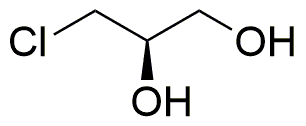(R)-(-)-3-Chloro-1,2-propanediol is widely utilized in research focused on
- Pharmaceutical Development: This compound serves as an important intermediate in the synthesis of various pharmaceuticals, particularly in the production of antiviral and antibacterial agents.
- Cosmetic Formulations: It is used in cosmetic products for its moisturizing properties, helping to enhance skin hydration and improve product stability.
- Food Industry: As a food additive, it acts as a preservative and flavoring agent, contributing to the shelf life and taste of certain food products.
- Research Applications: In laboratories, it is employed in chemical synthesis and as a reagent in organic chemistry, facilitating the study of reaction mechanisms and compound behavior.
- Polymer Production: This chemical is utilized in the production of polyols for polyurethane foams, offering improved flexibility and durability in various applications, including furniture and automotive industries.
General Information
Properties
Safety and Regulations
Applications
(R)-(-)-3-Chloro-1,2-propanediol is widely utilized in research focused on
- Pharmaceutical Development: This compound serves as an important intermediate in the synthesis of various pharmaceuticals, particularly in the production of antiviral and antibacterial agents.
- Cosmetic Formulations: It is used in cosmetic products for its moisturizing properties, helping to enhance skin hydration and improve product stability.
- Food Industry: As a food additive, it acts as a preservative and flavoring agent, contributing to the shelf life and taste of certain food products.
- Research Applications: In laboratories, it is employed in chemical synthesis and as a reagent in organic chemistry, facilitating the study of reaction mechanisms and compound behavior.
- Polymer Production: This chemical is utilized in the production of polyols for polyurethane foams, offering improved flexibility and durability in various applications, including furniture and automotive industries.
Documents
Safety Data Sheets (SDS)
The SDS provides comprehensive safety information on handling, storage, and disposal of the product.
Product Specification (PS)
The PS provides a comprehensive breakdown of the product’s properties, including chemical composition, physical state, purity, and storage requirements. It also details acceptable quality ranges and the product's intended applications.
Certificates of Analysis (COA)
Search for Certificates of Analysis (COA) by entering the products Lot Number. Lot and Batch Numbers can be found on a product’s label following the words ‘Lot’ or ‘Batch’.
*Catalog Number
*Lot Number
Certificates Of Origin (COO)
This COO confirms the country where the product was manufactured, and also details the materials and components used in it and whether it is derived from natural, synthetic, or other specific sources. This certificate may be required for customs, trade, and regulatory compliance.
*Catalog Number
*Lot Number
Safety Data Sheets (SDS)
The SDS provides comprehensive safety information on handling, storage, and disposal of the product.
DownloadProduct Specification (PS)
The PS provides a comprehensive breakdown of the product’s properties, including chemical composition, physical state, purity, and storage requirements. It also details acceptable quality ranges and the product's intended applications.
DownloadCertificates of Analysis (COA)
Search for Certificates of Analysis (COA) by entering the products Lot Number. Lot and Batch Numbers can be found on a product’s label following the words ‘Lot’ or ‘Batch’.
*Catalog Number
*Lot Number
Certificates Of Origin (COO)
This COO confirms the country where the product was manufactured, and also details the materials and components used in it and whether it is derived from natural, synthetic, or other specific sources. This certificate may be required for customs, trade, and regulatory compliance.

